Echeveria Agavoides Profile
Written by Iris
Nov 03 2021
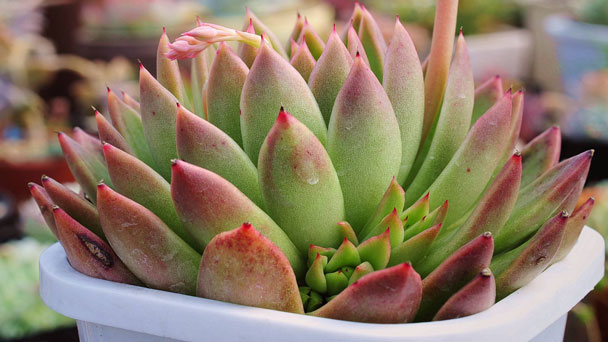
Echeveria Agavoides is a stemless, rosette - forming succulent plant that can grow up to 5 inches tall. The green leaves of Echeveria Agavoides are triangular with reddish edges and spines at the ends. Echeveria Agavoides has pink flowers with dark yellow tips.
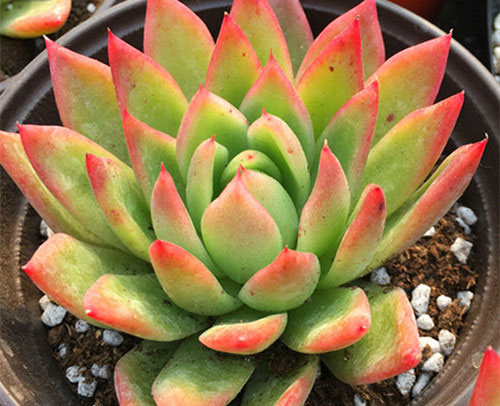
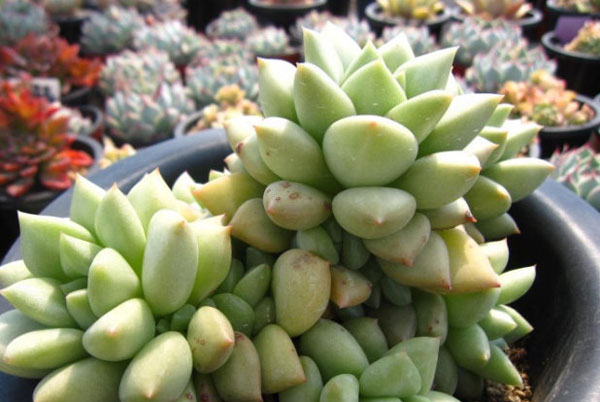
Cuttings are probably the most common method of propagating Echeveria Agavoides. It is recommended to start with a healthy leaf. Nevertheless, Echeveria Agavoides leaves can also be removed when shed from Echeveria Agavoides. Use a sharp blade or kitchen blade to cut off the edges of the leaves, making sure there are no large stems at the bottom of each piece. Form a natural seal before potting. Place each Echeveria Agavoides slice into a juicy potted mixture until roots form (usually about two weeks). Once the leaves are planted, carefully remove the new Echeveria Agavoides from the potted mixture and place in a sunny light position. Keep the soil moist, but not wet. If they are too dry, root rot can develop before they can establish their own roots. The best time to harvest chrysanthemum leaves for reproduction is when they are actively growing in summer or autumn. This ensures that more roots will form. In the meantime, there's still plenty of sunlight to grow fast.
Echeveria Agavoides Propagation with Stem Cuttings
Echeveria Agavoides stem cuttings are an easy way to propagate and grow this succulent plant. Make an incision at least 4 inches long. Trim the cutting process so that the surface is flat and cut off any leaves on top or below the area. Place the stem cuttings of Echeveria Agavoides in a container containing gravel, a mixture of cactus potting soil (a succulent mixture), or another porous material, such as perlite. Stay wet but not wet for two weeks, then go outside in the warmer months to enjoy plenty of sunshine. When the plant is 12 inches tall, put it in a container. Use water as needed to keep the soil moist.
Echeveria Agavoides Propagation with Division
Migration is the most common reproductive mode of Echeveria Agavoides. Produces a small offset at the base of the rosette. Offsets can be extracted from the parent plant and then potted in a well-drained soil mixture. Echeveria Agavoides produced more offsetting if they were grown in brighter light for a few hours a day or for a longer period (14 weeks). When the offset reaches about 3 inches high, it should be transplanted.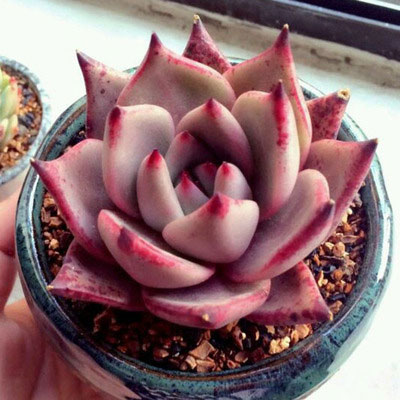
Similar to other echanthoid species, Echeveria Agavoides is grown in sufficient or partial sunlight. If growing echeveria Agavoides in the garden, place it for 6 hours of sunshine in the morning.
Soil Care
Choose soil for Echeveria Agavoides, you should use a mix of high quality juicy and cactus soil to provide great drainage as it is super important juicy. If you want to drain, injecting some mineral gravel is also a good idea.If you want the best drainage system, you can use pearl sand or coarse sand, or even both.
Water Care
Watering Echeveria Agavoides is actually simple because there are only a few factors affecting how often you water.One of these factors is the general weather conditions in your area. For example, if you live in a hot or dry place, then you will be more frequent than your water in cold or wet places.This has to do with the fast or slow soil in your area because it is really the most important thing to keep in mind.
Temperature Care
At the USDA, Echeveria Agavoides survived in winter 10 and higher and produced large cover plants for rock gardens.However, if staying outside, the Echeveria Agavoides will require a mild full-year climate. Echeveria Agavoides is very sensitive to cold and temperature drops drops and it will be unbearable.But if you live in a relatively warm winter area, you can still enjoy these beautiful succulent plants, grow them in indoor pots, or move them indoors for the cold winters.Like many water-absorbing plants, the biggest problem with growing Echeveria Agavoides is that they don't get as much sunlight as they are outdoors.
Fertilizer Care
The Echeveria Agavoides does not need to undergo regular fertilization.If you find that juicy begins to wither or yellow, it may be time to fertilize. If Echeveria Agavoides, even after a few months, show no signs of withering or death, then they don't need any fertilizer at all, and rain alone has enough nutrition.
Pruning Care
Little trimming is required except in the old Echeveria Agavoides. When height is excessive, can be trimmed, the top can be cut off, side branches, and eventually form a complete Echeveria Agavoides plant. Remove withered flowers (dehydrated) regularly.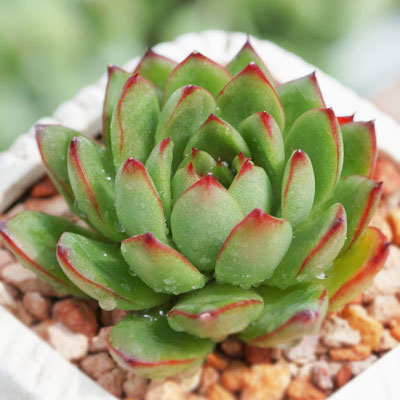
‘Prolifera’
Also called Carpet Echeveria, this succulent has full and tight rosettes. Its leaves are bright green with tips so light they're more pink than red. Prolifera grows offsets much more willingly than other agavoides, enabling it to spread out over time.
‘Maria’
The green and red contrast boldly and beautifully in this form. The red tips often end up rimming the entire top half of each leaf. This bright color also extends slightly down the leaf's spine. The rosette of this form is larger than the basic agavoides; it grows up to 14 inches wide.
‘Lipstick’
The lime green leaves of this plant indeed look like they’ve been lined in lipstick. Dark red rims the edges, adding a delicate touch to the whole rosette.
‘Ebony’
While not black as the name implies, this is definitely a darker form of wax Echeveria. The leaves are greyish green, giving the succulent a shadowy look. Instead of just tips, the whole edge of each leaf is bright red. This coloring gets darker towards the center of the rosette.
‘Aquamarine’
This form is only red on the very tips of the blue-green leaves. The rosette is extra chunky, giving this succulent some cute personality.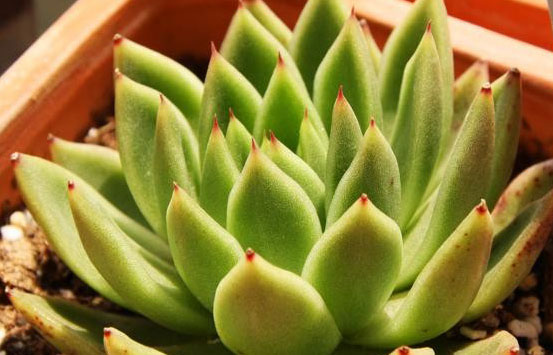
Read Next:
Echeveria Elegans Mexican Snowballs Care & Growing Guide
Echeveria Laui (Echeveria Succulent) Care Guide
Echeveria Agavoides Care & Propagation
Echeveria Pulvinata (Chenille Plant) Care & Propagation Guide
Echeveria Nodulosa (Painted Echeveria) Care Guide
Echeveria Imbricata (Blue Rose Echeveria) Grow & Care Guide
Echeveria Setosa: Grow & Care for Mexican Firecracker
Echeveria Black Prince Succulent Grow & Care Guide
Echeveria Runyonii Topsy Turvy Grow & Care Guide
Echeveria Takasago No Okina Care Guide
Echeveria Mebina Care Guide
Echeveria Agavoides PictureEcheveria Agavoides InfoEcheveria Agavoides Native HabitsEcheveria Agavoides DistributionHow to Grow & Care for Echeveria AgavoidesHow to Grow Echeveria AgavoidesHow to Care for Echeveria AgavoidesEcheveria Agavoides UsesEcheveria Agavoides VarietiesEcheveria Agavoides Common Pests/Diseases
Echeveria Agavoides Picture

Echeveria Agavoides Info
| Common Name(s) | Wax Agave, Molded Wax Echeveria, Crested Molded Wax Agave, House Leek |
| Scientific Name | Echeveria Agavoides |
| Family | Crassulaceae |
| Height & Spread | 5″ tall, 8″ wide |
| Light | Full sun, partial shade |
| Water | “Soak and dry” method |
| Soil | Well-draining |
| Fertilizer | Half-strength, liquid, balanced or low- Nitrogen |
Echeveria Agavoides Native Habits
Echeveria Agavoides is a small, stemless succulent, 8 -- 12 cm (3.1 -- 4.7 in) tall, with leaves 7 -- 15 cm (2.8 -- 5.9 in) in diameter. It is usually left alone, but older plants in good condition will grow to counteract it. The leaves are green, triangular, thicker (6mm) and sharper than other echeverias. Some species with bright light have reddish or bronze tips, and some species have slight to very red edges. The summer inflorescences occur on slender monofaced cymes up to 50 cm long. The flowers are pink, orange or red, with dark yellow tips.Echeveria Agavoides Distribution
Echeveria Agavoides, or lipstick echeveria, is a species of flowering plant in the family Crassulaceae, native to rocky areas of Mexico, notably the states of San Luis Potosí, Hidalgo, Guanajuato and Durango.
How to Grow & Care for Echeveria Agavoides
How to Grow Echeveria Agavoides
Echeveria Agavoides Propagation with LeavesCuttings are probably the most common method of propagating Echeveria Agavoides. It is recommended to start with a healthy leaf. Nevertheless, Echeveria Agavoides leaves can also be removed when shed from Echeveria Agavoides. Use a sharp blade or kitchen blade to cut off the edges of the leaves, making sure there are no large stems at the bottom of each piece. Form a natural seal before potting. Place each Echeveria Agavoides slice into a juicy potted mixture until roots form (usually about two weeks). Once the leaves are planted, carefully remove the new Echeveria Agavoides from the potted mixture and place in a sunny light position. Keep the soil moist, but not wet. If they are too dry, root rot can develop before they can establish their own roots. The best time to harvest chrysanthemum leaves for reproduction is when they are actively growing in summer or autumn. This ensures that more roots will form. In the meantime, there's still plenty of sunlight to grow fast.
Echeveria Agavoides Propagation with Stem Cuttings
Echeveria Agavoides stem cuttings are an easy way to propagate and grow this succulent plant. Make an incision at least 4 inches long. Trim the cutting process so that the surface is flat and cut off any leaves on top or below the area. Place the stem cuttings of Echeveria Agavoides in a container containing gravel, a mixture of cactus potting soil (a succulent mixture), or another porous material, such as perlite. Stay wet but not wet for two weeks, then go outside in the warmer months to enjoy plenty of sunshine. When the plant is 12 inches tall, put it in a container. Use water as needed to keep the soil moist.
Echeveria Agavoides Propagation with Division
Migration is the most common reproductive mode of Echeveria Agavoides. Produces a small offset at the base of the rosette. Offsets can be extracted from the parent plant and then potted in a well-drained soil mixture. Echeveria Agavoides produced more offsetting if they were grown in brighter light for a few hours a day or for a longer period (14 weeks). When the offset reaches about 3 inches high, it should be transplanted.

How to Care for Echeveria Agavoides
Light CareSimilar to other echanthoid species, Echeveria Agavoides is grown in sufficient or partial sunlight. If growing echeveria Agavoides in the garden, place it for 6 hours of sunshine in the morning.
Soil Care
Choose soil for Echeveria Agavoides, you should use a mix of high quality juicy and cactus soil to provide great drainage as it is super important juicy. If you want to drain, injecting some mineral gravel is also a good idea.If you want the best drainage system, you can use pearl sand or coarse sand, or even both.
Water Care
Watering Echeveria Agavoides is actually simple because there are only a few factors affecting how often you water.One of these factors is the general weather conditions in your area. For example, if you live in a hot or dry place, then you will be more frequent than your water in cold or wet places.This has to do with the fast or slow soil in your area because it is really the most important thing to keep in mind.
Temperature Care
At the USDA, Echeveria Agavoides survived in winter 10 and higher and produced large cover plants for rock gardens.However, if staying outside, the Echeveria Agavoides will require a mild full-year climate. Echeveria Agavoides is very sensitive to cold and temperature drops drops and it will be unbearable.But if you live in a relatively warm winter area, you can still enjoy these beautiful succulent plants, grow them in indoor pots, or move them indoors for the cold winters.Like many water-absorbing plants, the biggest problem with growing Echeveria Agavoides is that they don't get as much sunlight as they are outdoors.
Fertilizer Care
The Echeveria Agavoides does not need to undergo regular fertilization.If you find that juicy begins to wither or yellow, it may be time to fertilize. If Echeveria Agavoides, even after a few months, show no signs of withering or death, then they don't need any fertilizer at all, and rain alone has enough nutrition.
Pruning Care
Little trimming is required except in the old Echeveria Agavoides. When height is excessive, can be trimmed, the top can be cut off, side branches, and eventually form a complete Echeveria Agavoides plant. Remove withered flowers (dehydrated) regularly.

Echeveria Agavoides Uses
Echeveria Agavoides is a great all-sun addition to any juicy garden, rock garden, or house plant display. Echeveria Agavoides also looks great growing in sunny windows due to its unique inflorescence.Echeveria Agavoides Varieties
Because it's commonly used to make hybrids, molded wax agave has many forms. Here are some of the most popular.‘Prolifera’
Also called Carpet Echeveria, this succulent has full and tight rosettes. Its leaves are bright green with tips so light they're more pink than red. Prolifera grows offsets much more willingly than other agavoides, enabling it to spread out over time.
‘Maria’
The green and red contrast boldly and beautifully in this form. The red tips often end up rimming the entire top half of each leaf. This bright color also extends slightly down the leaf's spine. The rosette of this form is larger than the basic agavoides; it grows up to 14 inches wide.
‘Lipstick’
The lime green leaves of this plant indeed look like they’ve been lined in lipstick. Dark red rims the edges, adding a delicate touch to the whole rosette.
‘Ebony’
While not black as the name implies, this is definitely a darker form of wax Echeveria. The leaves are greyish green, giving the succulent a shadowy look. Instead of just tips, the whole edge of each leaf is bright red. This coloring gets darker towards the center of the rosette.
‘Aquamarine’
This form is only red on the very tips of the blue-green leaves. The rosette is extra chunky, giving this succulent some cute personality.

Echeveria Agavoides Common Pests/Diseases
Echeveria Agavoides is susceptible to squamous and beetles.These pests can usually be cleared by cleaning them with water or with a diluted soap solution, but they may reappear over time. If the plant is infected, it is best to discard both pests and any egg sac placed in its soil. That will prevent a recovery in the coming months. Echeveria Agavoides also suffers from grey mold, with fuzzy patches on the leaves. For most plants with this fungus, this problem should resolve naturally if you remove dead leaves immediately when you first develop symptoms. However, plants with the weaker immune system or Echeveria Agavoides grown in humid environments will most likely die after the first round of infection.For Echeveria Agavoides, fungicides were used to prevent the spread of further contamination.Read Next:
Echeveria Elegans Mexican Snowballs Care & Growing Guide
Echeveria Laui (Echeveria Succulent) Care Guide
Echeveria Agavoides Care & Propagation
Echeveria Pulvinata (Chenille Plant) Care & Propagation Guide
Echeveria Nodulosa (Painted Echeveria) Care Guide
Echeveria Imbricata (Blue Rose Echeveria) Grow & Care Guide
Echeveria Setosa: Grow & Care for Mexican Firecracker
Echeveria Black Prince Succulent Grow & Care Guide
Echeveria Runyonii Topsy Turvy Grow & Care Guide
Echeveria Takasago No Okina Care Guide
Echeveria Mebina Care Guide
Latest Updated
- Benefits of Bugleweed - 7 Science-backed Health Benefits
- Bugleweed Dangers & Side Effects - Is It Poisonous?
- How to Plant Evergreen Trees - What You Should Know
- When to Plant Evergreens - Grow Guide for Evergreen Trees
- 12 Wonderful Evergreen Shrubs for Your Garden
- 12 Popular Evergreen Plants with Pictures for Beginners
- When And How To Prune A Lilac Bush Like a Pro
- How to Grow & Care for Lilac Vine (Hardenbergia Violacea)
- Japanese Lilac Tree (Syringa Reticulata) Care & Propagation Guide
- Shumard Oak Pros and Cons - What to Know
Popular Articles
- Winter maintenance of Antirrhinum Majus
- How to Grow Terminalia Mantaly Tree
- How to Grow and Care for Crossostephium Chinense
- How to grow Antirrhinum Majus in spring
- Peristeria Elata (Dove Orchid) Profile: Info & Care Guide
- Underwatered Snake Plant (Sansevieria Trifasciata) - Signs And How To Fix
- How to Care for Brazilian Jasmine Plant (Mandevilla Sanderi)
- How to Grow & Care for Graptopetalum Purple Delight in Summer
- Rosa Chinensis (China Rose): Plant Growing & Care Tips
- How to Care for Baby Sun Rose (Aptenia Cordifolia)